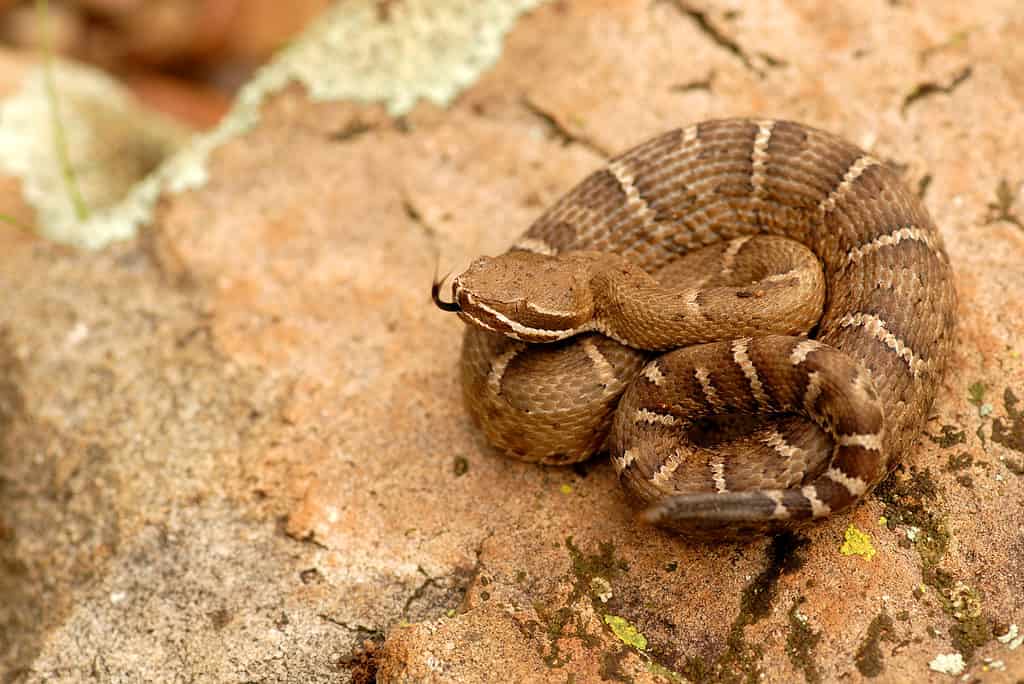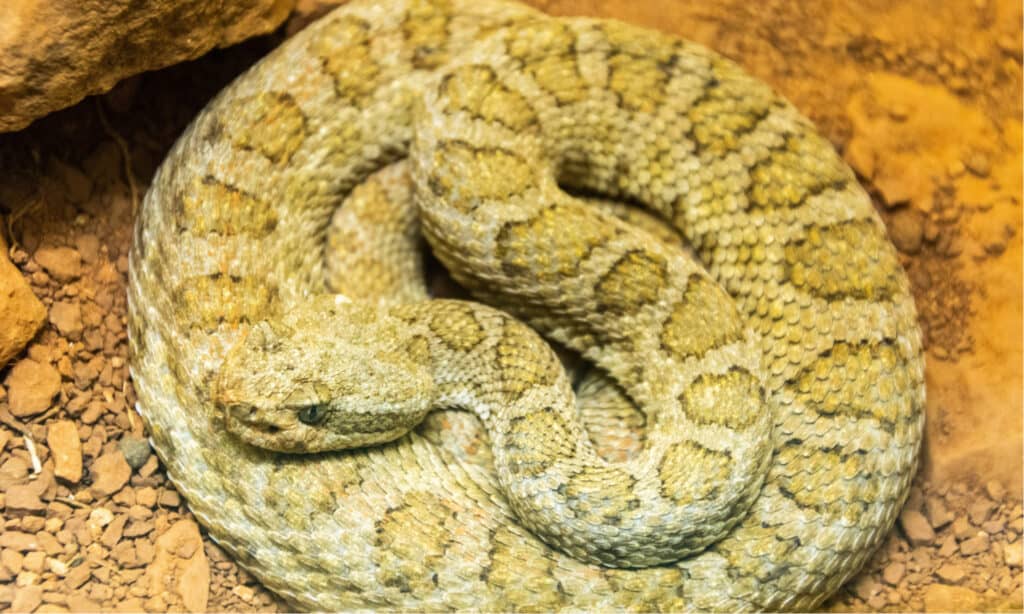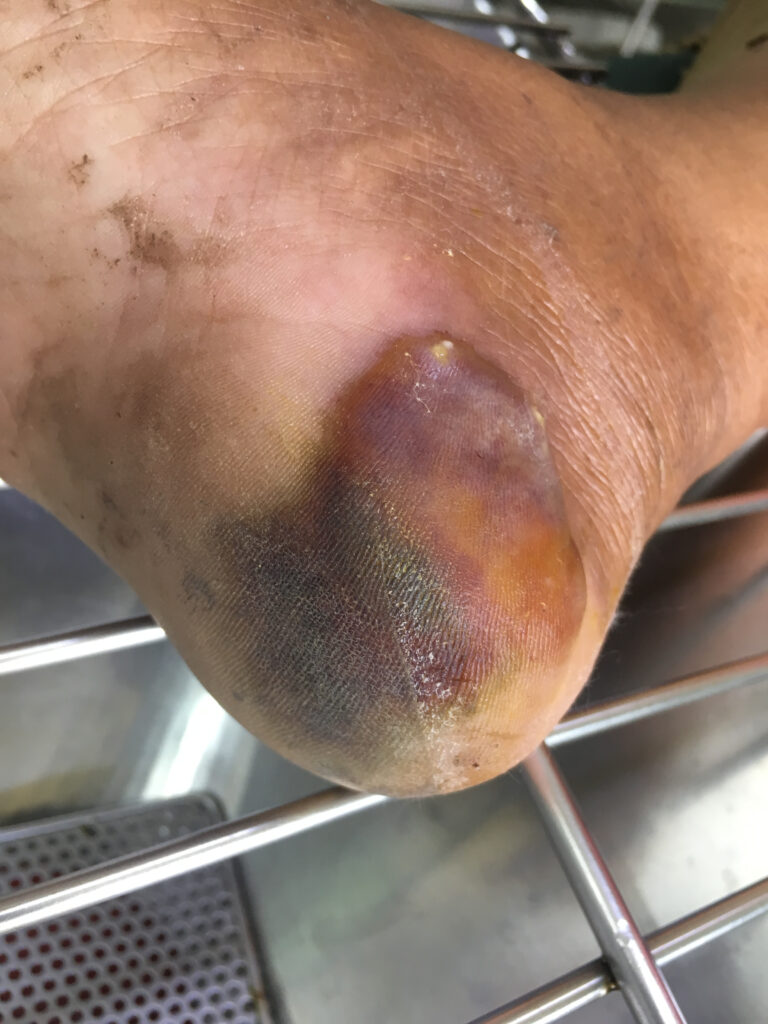Rattlesnake Season in Colorado is from early spring to mid-fall.
Rattlesnakes are one of the most feared species of snakes. On the one hand, it makes sense, because about 800 people in the United States get bitten by these venomous pit vipers every year. But on the other hand, out of all those bitten, all but about a dozen make a full recovery in days or weeks. Rattlesnakes have an extremely effective warning system, though: that buzzing rattle is enough to rattle anyone! For a lot of people, it creates a level of horror around this species that is out of proportion to the actual danger.
Colorado has several species of rattlesnakes. In this article, we compare snake species to help you recognize them, suggest ways to avoid encounters with them, and go over some basic first aid. You’ll want to read that part carefully, as the current best practices in treating rattlesnake bites aren’t what you might have seen in old Westerns.

Rattlesnakes bite over 800 people in the United States every year, but only a dozen or so die from being bitten.
©Maria Dryfhout/Shutterstock.com
Rattlesnake Habitat and Behavior?
Rattlesnakes live all over North America in a variety of climates. They’re extremely adaptable, and really just require a few things to thrive. First off, they need a source of small animals, usually rodents, for food. Rabbits, mice, rats, prairie dogs, squirrels, chipmunks: anything like that will work. Like all reptiles, rattlesnakes are cold-blooded. This means they cannot maintain a constant body temperature themselves, from the interior, but regulate their temperature based on their external environment. When they get cold, they need a sunny rock or path to catch some rays. When it’s too hot, they need some shade. In places where the temperature drops quite cold in the winter, rattlesnakes go into a slowed-down state that is not entirely hibernation, but close to it.
Although they are usually solitary predators, in the winter they sometimes share a burrow with other snakes or reptiles that aren’t even of the same species. They seem to have a truce with these potential enemies or food sources so they can benefit from some shared warmth.
Why is Colorado Heaven for Rattlesnakes?
All of this makes Colorado an ideal environment for several species of rattlesnakes. Rattlesnake Season in Colorado is from early spring to mid-fall, but people spot them at other times of the year on a pretty regular basis as well. The state’s different climate zones, with high precipitation areas and more arid areas, and its prairie, river, and mountain habitats offer a wide variety of living conditions and support a lot of diverse wildlife that can potentially make a meal for a rattlesnake. It’s also helpful that, although the human population of Colorado has grown explosively in recent years, much of that growth has taken place in the cluster of large urban centers down the center of the state in the foothills of the Rocky Mountains. There are still seemingly endless miles of unspoiled wilderness and wildlife to flourish.

Because rattlesnakes cannot regulate their own body temperature, you might see one on a sunny day basking on a rock or lying on a trail.
©Rusty Dodson/Shutterstock.com
How Can You Recognize a Rattlesnake?
Some of the characteristics you can look for if you see a random snake and wonder if it is a rattlesnake are these: a large, triangular head, vertical pupils, a thick, heavy body, coloration in earth tones in shades of brown, grey, or black. They may have a horizontal striped or spotted pattern. And of course, the most tell-tale sign is that rattle on the end of their tails, but this may not be as obvious as you think.
Baby rattlesnakes are born live, not from eggs, and they are venomous from birth. However, they will have just a button at the end of their tail for their first rattle, and a new segment of the rattle will be added each time they shed their skin, up to eight to 10 segments. So, if you find a very small snake and don’t see a rattle, it could still be a highly venomous baby rattlesnake just faking you out. On the other hand, the bull snake looks an awful lot like a rattlesnake, but they are non-venomous and should not be killed. They eat lots of rodents, and the more they eat, the less food is left for rattlesnakes to multiply and eat.

Rattlesnakes add a new segment to their rattles each time they shed their skin.
©Chase D’animulls/Shutterstock.com
What Kinds of Rattlesnakes Live in Colorado?
There are 29 different species of snakes living in Colorado. Three of them are rattlesnakes. The time of year they are most active is in early spring through mid-fall, although depending on the weather and where you are in the state, you might see them any time of the year. Remember that rattlesnakes do not completely hibernate in the winter. They may emerge on a sunny day to warm themselves or to take advantage of an opportunity to catch some food. They are most aggressive when they emerge from their burrows in spring and early summer, hungry and cranky. Sometimes people nickname any species of rattlesnake as a “rattler,” which is fine, but you might also hear them referred to as “diamondbacks.” This term actually just applies to the Western Diamondback Rattlesnake, which does not live in Colorado. These are the three species that are found in the state:
Prairie Rattlesnake
Prairie rattlesnakes live in the central plains’ region of the United States and Canada in prairie and wooded mountain habitats. They get to be 3-4 feet long and have a greenish tinge mixed with gray or brown. Some can be light brown or yellow. One of the prey species of the prairie rattlesnake is the prairie dog. After a rattlesnake has cleared out a system of prairie dog tunnels it may continue to live there and raise its young. Females give birth to anywhere from 5-25 young, but many of the babies are eaten by carnivores, including mammals, predatory birds, and king snakes.

Prairie rattlesnakes eat prairie dogs and use their burrows for themselves.
©taviphoto/Shutterstock.com
Massasauga Rattlesnake
The massasauga rattlesnake has grey or tan coloration with brown or black spots down the center of their back and smaller spots on their sides. They prefer to live in wetlands along the shores of rivers and lakes. When they are young, they eat smaller snakes, amphibians, and insects but as adults, their main prey is small mammals.

The massasauga rattlesnake lives in swampy areas near rivers and lakes.
©Ryan M. Bolton/Shutterstock.com
Midget Faded Rattlesnake
The midget faded rattlesnake is only about two feet long and has a light color without very pronounced patterns. It lives mainly in rocky canyon areas. Its venom is one of the most toxic of any North American snake – even more toxic than a cobra. But fortunately, like most other rattlesnakes, it prefers to keep to itself and will flee from humans if it can.

The midget faded rattlesnake has a light coloration that helps it blend into the rocky, sandy habitat it frequents.
©Alizada Studios/Shutterstock.com
About Rattlesnake Bites
Rattlesnakes prefer to get away, but if they feel cornered or threatened, they will give a warning with their rattle. If that doesn’t work, they bite. They can strike out about 2/3 of their body length. They have fangs that fold back so that they don’t bite themselves when they close their mouths. The fangs are hollow and the snake can decide whether or not to inject venom. It takes a lot of energy for the snake to produce venom, so they don’t want to waste it. It’s intended to immobilize prey so the snake can eat it.
About 25 percent of bites are “dry” (non-venomous) bites. However, even those kinds of bites can make a bad wound and introduce some trace toxins that interfere with blood clotting in the wound and can cause the victim to experience shock. Any time a person is bitten, they need to see a medical professional, as it is not possible to tell right away whether or how much venom was injected.

One in four rattlesnake bites is a dry bite, but these can still cause great pain and localized issues that need medical attention.
©Chuanpit/Shutterstock.com
How to Avoid and Survive a Rattlesnake Bite
Most rattlesnake bites happen when someone accidentally steps on or near the snake, or when they deliberately try to handle it or kill it. So, if you make noise when you walk to scare them off and go the other way if you see one, half the battle is done. Here are some other ideas to help you avoid getting bitten during rattlesnake season in Colorado:
Avoiding a Rattlesnake Bite
- Don’t try to pick up, poke at, or kill a rattlesnake. If it needs catchin’ or killin’ call the professionals.
- Stay on-trail. Wandering through tall grass is inviting trouble.
- Place your hands and feet where you can see them.
- Don’t walk when it’s dark, when snakes may be hunting.
- Protect your feet and legs with long pants and closed shoes.
- Make some noise when walking – rustle leaves, take heavy steps – so snakes and other creatures know you’re coming and get out of the way.
- If you listen to headphones while walking, keep them turned low enough to hear rattling sounds.
- When camping, shake out your sleeping bag, clothes, and shoes before using them. Snakes may be attracted to residual body heat.
- If you’re moving a rock or log at your campsite, roll it towards you. This gives anything underneath the opportunity to flee.
- If you hear a rattling sound, move away from the sound.
- Stay away from seemingly dead snakes. Sometimes they’re just injured and still have some fight in them. Even if the head has been severed, it can still bite reflexively and inject venom.
- Did you know these bad boys can swim? They can. So, when you’re out on a boat and a “stick” floats by, just let it keep on floating away.
- Deny snakes hiding places on your property. Keep your grass and shrubbery well-trimmed and dispose of any brush piles or unused items. If you’ve seen snakeskins around, then maybe call some professionals to handle this cleanup and watch from your kitchen window.
- Keep your dogs safe by keeping them on a leash and not letting them roam wherever they want.

During rattlesnake season in Colorado, always walk your dog on a leash.
©Christian Mueller/Shutterstock.com
Do Not Do That Old West Stuff
If you get bitten, absolutely do not do anything you saw in an Old West movie, unless you are trying to get yourself buried in an Old West cemetery. Specifically:
- Do not get out your big bowie knife and make an incision over the bite marks.
- Do not let some old prospector suck the poison out of the wound. It just makes two victims.
- Do not use your cowboy bandana or a belt as a tourniquet. No tourniquets!
- Do not take a drink of alcohol from your flask. Alcohol can speed up venom absorption.
- Do not burst into a saloon, run over to the bar, and grab the ice out of someone’s drink to put on the bite. Ice slows circulation to the area and can put the flesh around the wound in danger.
- Don’t chop off the affected limb. A severed limb is a more life-threatening injury than a snakebite.

Do not follow this man’s advice to treat a snake bite. Sadly, he is no longer among the living.
©chippix/Shutterstock.com
New West Stuff for a Snakebite
Act like there’s been a hundred years of scientific advancement since the Old West and do these New West things:
- Stay calm. A rapidly beating heart circulates the venom.
- Call 911 for help, or use a radio if you don’t have phone service.
- Keep the wound below the level of the heart to slow the spread of toxins.
- Rinse the bite area with soap and room-temperature water.
- Take off any of your fancy city things like watches, rings, or bracelets that may get stuck and cut off circulation as the wounded limb swells.
- If you have a snakebite kit, see if it has a suction device to draw venom out of the wound. You can use this while you wait for help.
- If it is quicker to drive the victim to the hospital than wait for an ambulance, do so efficiently, but not recklessly. Driving fast will increase the victim’s heart rate and could cause an accident that will delay treatment or cause even more serious injuries to the victim and others.
- If your dog was bitten, take it to an emergency vet ASAP.

After a snakebite, move as quickly as possible to a place where the scenery looks like this. Medical scenery means you will live.
©Ground Picture/Shutterstock.com
Doc, What Are My Chances?
If you’re bitten by a rattlesnake, chances are overwhelming that you are going to recover completely in a few days. You’ll get antivenom and come out of it with some scars and a story. More people die from allergic reactions to bee stings than from rattlesnake bites. If you leave rattlesnakes alone, take away their hiding places on your property, and tread cautiously when you’re in theirs, you’ll be fine.
The photo featured at the top of this post is © Matt Jeppson/Shutterstock.com
Discover the "Monster" Snake 5X Bigger than an Anaconda
Every day A-Z Animals sends out some of the most incredible facts in the world from our free newsletter. Want to discover the 10 most beautiful snakes in the world, a "snake island" where you're never more than 3 feet from danger, or a "monster" snake 5X larger than an anaconda? Then sign up right now and you'll start receiving our daily newsletter absolutely free.
Thank you for reading! Have some feedback for us? Contact the AZ Animals editorial team.







